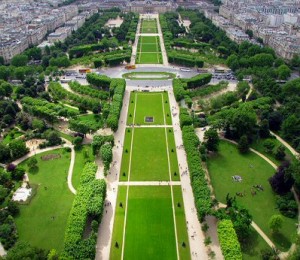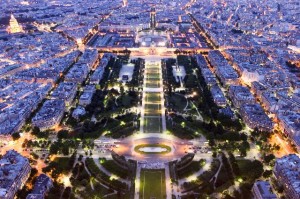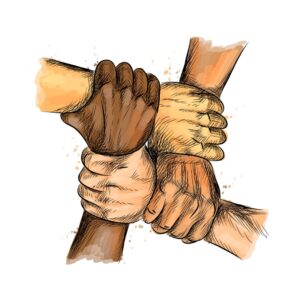Champ de Mars: Gateway to the Eiffel Tower

The Champ de Mars, translated the Field of Mars, is the vast public space which lies between the Eiffel Tower and the Military School. The expansive lawns, the popular collections of flowers and trees and attractions such as live music and children’s shows make the area a perfect spot for leisure activities. The field is a large area of nearly 240,000 square meters; it is approximately 800 feet wide and one half mile in length, and is formed from a single axis which lies perpendicular to the Seine River. The field was planned from 1765-1767, and was originally used as a practice area for the adjacent Military School. Because of its original use, it was called the Field of Mars after the Roman god of war. During the time that the space was laid out, much of the surrounding area was still rural country land.
 Shortly after its formation, the Champ de Mars became a public meeting place due to its size and location near the center of Paris. It has been the site of the World’s Fair each time it has been in Paris, and was also the site of a horse racecourse in the mid 1800’s. The gardens which currently exist were laid out between 1908 and 1928. The field consists of a central lawn which is flanked by two large walkways and intersected by several small perpendicular walkways. The large walkways are partially shaded by rows of trees which extend along both sides of the entire length of the space. The field is cut in half by a wide circular road which surrounds a shallow pool, the centerpiece of the garden. This center point is intersected by a boulevard which curves around the pool and allows for vehicle access.
Shortly after its formation, the Champ de Mars became a public meeting place due to its size and location near the center of Paris. It has been the site of the World’s Fair each time it has been in Paris, and was also the site of a horse racecourse in the mid 1800’s. The gardens which currently exist were laid out between 1908 and 1928. The field consists of a central lawn which is flanked by two large walkways and intersected by several small perpendicular walkways. The large walkways are partially shaded by rows of trees which extend along both sides of the entire length of the space. The field is cut in half by a wide circular road which surrounds a shallow pool, the centerpiece of the garden. This center point is intersected by a boulevard which curves around the pool and allows for vehicle access.
The Champ de Mars is famous for its role in the French Revolution. On July 14, 1790, it was the site of a celebration for the one-year anniversary of the storming of the Bastille. The field was also the site of a political gathering where a large group gathered to petition the removal of the King, Louis XVI on July 17, 1791. Under the command of Marquis de la Fayette, French soldiers began firing at the demonstrators. The altercation, now known as the Massacre at the Champ de Mars, ended with the death of about 50 civilians.
The Champ de Mars is probably more famous for its surrounding monuments than it is for anything else. The Military School (École Militaire), which was commissioned under King Louis XV and finished in 1772, is a large complex of buildings including both living quarters and teaching facilities. The schools which now comprise the École Militaire are among the elite educational institutions in France. The Eiffel Tower, of course is the most recognizable monument that encloses the Field of Mars. It is often regarded as the most famous national landmark in the world. The tower, which was constructed for the World’s Fair in 1889 by Alexander Gustave Eiffel, has seen over 200 million visitors in its relatively brief history. It was an extremely remarkable structure at the time of its construction, and was the tallest structure in the world for 40 years. It stands 986 feet tall, weighs over 10,000 tons, and comprises over 18,000 pieces of steel. In spite of the criticism that Eiffel received during the design process, the tower is now considered to be one of the most successful pieces of architectural art in existence.
visitors in its relatively brief history. It was an extremely remarkable structure at the time of its construction, and was the tallest structure in the world for 40 years. It stands 986 feet tall, weighs over 10,000 tons, and comprises over 18,000 pieces of steel. In spite of the criticism that Eiffel received during the design process, the tower is now considered to be one of the most successful pieces of architectural art in existence.
The Champ de Mars is undeniable an integral piece of Paris’s urban environment. It serves as a foreground and a connecting axis to some of the city’s most visited attractions, and because of the welcoming features such as the shade trees and vast grassy fields, it is a popular gathering point for tourists and residents. Though the specific use of the field has changed throughout its history, Parisians have always been able to se the desirable features of the garden to successfully incorporate the space as an important piece of the region.







